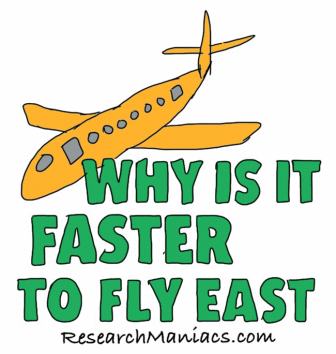
We posted this question to Research Maniacs visitors
and got four answers:
Answer 1) Earth rotates around its own axis. The sun comes up
in the east and goes down in the west, so you know the earth
spins from west towards east. It other words, if you
are located above the North Pole and look down, you will
see that Earth is rotating counter clockwise.
That means as you travel east, east will meet you on
the way and therefore you reach it sooner and it
is faster.
Answer 2) It is simply a matter of time zones. For example
the East Coast is three hours a head of the West Coast.
Therefore, you are traveling forward in time when you
travel east and therefore it is faster.
Answer 3) Gas is usually cheaper the more west you go. So, it
is OK to burn more gas when you go west to east -
and thus you can go faster because pilots have to be
less concerned with gas mileage.
Answer 4) There are constant global winds (jet streams) above Earth
that travel east. Airplanes often take advantage of
these winds by traveling in them. This extra push makes
it faster to travel east than west.
Answer 1 is incorrect. You and the airplane are
relative to Earth and Earth's rotation does not influence
how fast you can travel from one place to another. Think
of if this way: Earth's rotation is 1024 mph at equator,
an airplane traveling 500 mph would then travel backwards
524 mph - which it obviously can not.
Answer 2 is also incorrect. Although the time zone may change,
you are still in the plane and time is ticking.
Answer 3 is incorrect. The premise itself is incorrect.
For example, gas is more expensive in Maui than it is
in San Francisco and not vice versa.
Answer 4 is correct. Airplanes take advantage of winds
to fly faster. The same way a sailboat can sail faster
with the wind than against the wind or a kayak can go faster
downstream than upstream. Note: This applies to most of the
northern hemisphere. Global streams are different around the
globe and especially different in the southern hemisphere.
|
|
